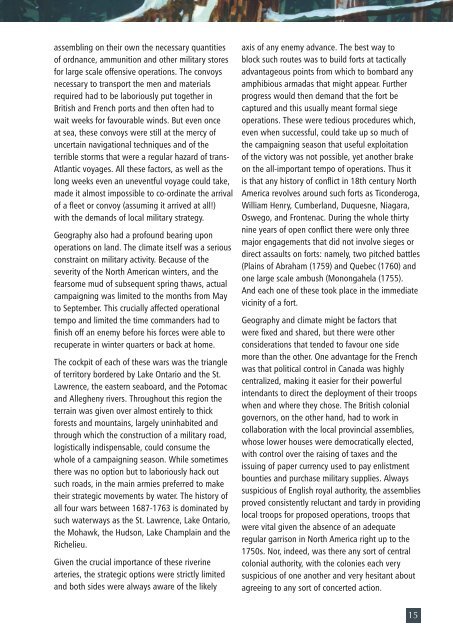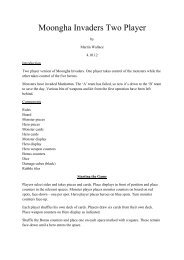A Few Acres Of Snow â 2nd Edition Rules (PDF) - Treefrog Games
A Few Acres Of Snow â 2nd Edition Rules (PDF) - Treefrog Games
A Few Acres Of Snow â 2nd Edition Rules (PDF) - Treefrog Games
Create successful ePaper yourself
Turn your PDF publications into a flip-book with our unique Google optimized e-Paper software.
assembling on their own the necessary quantities<br />
of ordnance, ammunition and other military stores<br />
for large scale offensive operations. The convoys<br />
necessary to transport the men and materials<br />
required had to be laboriously put together in<br />
British and French ports and then often had to<br />
wait weeks for favourable winds. But even once<br />
at sea, these convoys were still at the mercy of<br />
uncertain navigational techniques and of the<br />
terrible storms that were a regular hazard of trans-<br />
Atlantic voyages. All these factors, as well as the<br />
long weeks even an uneventful voyage could take,<br />
made it almost impossible to co-ordinate the arrival<br />
of a fleet or convoy (assuming it arrived at all!)<br />
with the demands of local military strategy.<br />
Geography also had a profound bearing upon<br />
operations on land. The climate itself was a serious<br />
constraint on military activity. Because of the<br />
severity of the North American winters, and the<br />
fearsome mud of subsequent spring thaws, actual<br />
campaigning was limited to the months from May<br />
to September. This crucially affected operational<br />
tempo and limited the time commanders had to<br />
finish off an enemy before his forces were able to<br />
recuperate in winter quarters or back at home.<br />
The cockpit of each of these wars was the triangle<br />
of territory bordered by Lake Ontario and the St.<br />
Lawrence, the eastern seaboard, and the Potomac<br />
and Allegheny rivers. Throughout this region the<br />
terrain was given over almost entirely to thick<br />
forests and mountains, largely uninhabited and<br />
through which the construction of a military road,<br />
logistically indispensable, could consume the<br />
whole of a campaigning season. While sometimes<br />
there was no option but to laboriously hack out<br />
such roads, in the main armies preferred to make<br />
their strategic movements by water. The history of<br />
all four wars between 1687-1763 is dominated by<br />
such waterways as the St. Lawrence, Lake Ontario,<br />
the Mohawk, the Hudson, Lake Champlain and the<br />
Richelieu.<br />
Given the crucial importance of these riverine<br />
arteries, the strategic options were strictly limited<br />
and both sides were always aware of the likely<br />
axis of any enemy advance. The best way to<br />
block such routes was to build forts at tactically<br />
advantageous points from which to bombard any<br />
amphibious armadas that might appear. Further<br />
progress would then demand that the fort be<br />
captured and this usually meant formal siege<br />
operations. These were tedious procedures which,<br />
even when successful, could take up so much of<br />
the campaigning season that useful exploitation<br />
of the victory was not possible, yet another brake<br />
on the all-important tempo of operations. Thus it<br />
is that any history of conflict in 18th century North<br />
America revolves around such forts as Ticonderoga,<br />
William Henry, Cumberland, Duquesne, Niagara,<br />
Oswego, and Frontenac. During the whole thirty<br />
nine years of open conflict there were only three<br />
major engagements that did not involve sieges or<br />
direct assaults on forts: namely, two pitched battles<br />
(Plains of Abraham (1759) and Quebec (1760) and<br />
one large scale ambush (Monongahela (1755).<br />
And each one of these took place in the immediate<br />
vicinity of a fort.<br />
Geography and climate might be factors that<br />
were fixed and shared, but there were other<br />
considerations that tended to favour one side<br />
more than the other. One advantage for the French<br />
was that political control in Canada was highly<br />
centralized, making it easier for their powerful<br />
intendants to direct the deployment of their troops<br />
when and where they chose. The British colonial<br />
governors, on the other hand, had to work in<br />
collaboration with the local provincial assemblies,<br />
whose lower houses were democratically elected,<br />
with control over the raising of taxes and the<br />
issuing of paper currency used to pay enlistment<br />
bounties and purchase military supplies. Always<br />
suspicious of English royal authority, the assemblies<br />
proved consistently reluctant and tardy in providing<br />
local troops for proposed operations, troops that<br />
were vital given the absence of an adequate<br />
regular garrison in North America right up to the<br />
1750s. Nor, indeed, was there any sort of central<br />
colonial authority, with the colonies each very<br />
suspicious of one another and very hesitant about<br />
agreeing to any sort of concerted action.<br />
15











